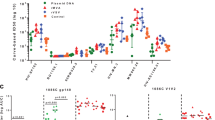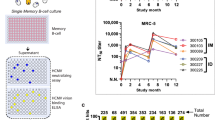Abstract
T-lymphocyte immunity is likely to be an important component of the immune defence against the AIDS virus, because helper T cells are necessary for the antibody response as well as the cytotoxic response. We have previously predicted two antigenic sites of the viral envelope protein gp120 likely to be recognized by T lymphocytes, based on their ability to fold as amphipathic helices, and have demonstrated that these are recognized by T cells of mice immunized with gp120 (ref. 1). A peptide corresponding to one of these sites can also induce immunity in mice to the whole gp120 protein1. Because many clinically healthy seropositive blood donors have already lost their T-cell proliferative response to specific antigen2,3, we tested the response to these synthetic peptides of lymphocytes from 14 healthy human volunteers who had been immunized with a recombinant vaccinia virus containing the AIDS viral envelope gene and boosted with a recombinant fragment. Eight of the 14 responded to one peptide, and four to the other peptide, not included in the boost. These antigenic sites recognized by human T cells may be useful components of a vaccine against AIDS. We also found a correlation between boosting with antigen-antibody complexes (compared to free antigen) and higher stimulation indices, suggesting a more effective method of immunization.
This is a preview of subscription content, access via your institution
Access options
Subscribe to this journal
Receive 51 print issues and online access
$199.00 per year
only $3.90 per issue
Buy this article
- Purchase on Springer Link
- Instant access to full article PDF
Prices may be subject to local taxes which are calculated during checkout
Similar content being viewed by others
References
Cease, K. B. et al. Proc. natn Acad. Sci. U.S.A. 84, 4249–4253 (1987).
Shearer, G. M. et al. J. Immun. 137, 2514–2521 (1986).
Wahren, B. et al. J. Virol. 61, 2017–2023 (1987).
DeLisi, C. & Berzofsky, J. A. Proc. natn. Acad. Sci. U.S.A. 82, 7048–7052 (1985).
Spouge, J. L. et al. J. Immun. 138, 204–212 (1987).
Margalit, H. et al. J. Immun. 138, 2213–2229 (1987).
Berzofsky, J. A. et al. Immun. Rev. 98, 9–52 (1987).
Chakrabarti, S., Robert-Guroff, M., Wong-Staal, F., Gallo, R. C. & Moss, B. Nature 320 535–537 (1986).
Zagury, D. et al. Nature 326, 249–250 (1987).
Zagury, D. et al. Nature 332, 728–731 (1988).
Krohn, K. et al. Proc. natn. Acad. Sci. U.S.A 84, 4994–4998 (1987).
Lasky, L. A. et al. Cell 50, 975–985 (1987).
Terres, G. & Wolins, W. J. Immun. 86, 361 (1961).
Möller, G. & Wigzell, H. J. exp. Med. 121, 969–989 (1965).
Uhr, J. W. & Möller, G. Adv. Immun. 8, 81–127 (1968).
Celis, E. & Chang, T. W. Science 224, 297–299 (1984).
Chang, T. W. Immun. Today 6, 245–249 (1985).
Author information
Authors and Affiliations
Rights and permissions
About this article
Cite this article
Berzofsky, J., Bensussant, A., Cease, K. et al. Antigenic peptides recognized by T lymphocytes from AIDS viral envelope-immune humans. Nature 334, 706–708 (1988). https://doi.org/10.1038/334706a0
Received:
Accepted:
Published:
Issue Date:
DOI: https://doi.org/10.1038/334706a0
This article is cited by
-
Targeting HIV Env immunogens to B cell follicles in nonhuman primates through immune complex or protein nanoparticle formulations
npj Vaccines (2020)
-
From therapeutic antibodies to immune complex vaccines
npj Vaccines (2019)
-
Converting monoclonal antibody-based immunotherapies from passive to active: bringing immune complexes into play
Emerging Microbes & Infections (2016)
-
Structural analysis of a novel rabbit monoclonal antibody R53 targeting an epitope in HIV-1 gp120 C4 region critical for receptor and co-receptor binding
Emerging Microbes & Infections (2015)
-
Vaccine therapies for chronic hepatitis B: can we go further?
Frontiers of Medicine (2014)
Comments
By submitting a comment you agree to abide by our Terms and Community Guidelines. If you find something abusive or that does not comply with our terms or guidelines please flag it as inappropriate.



